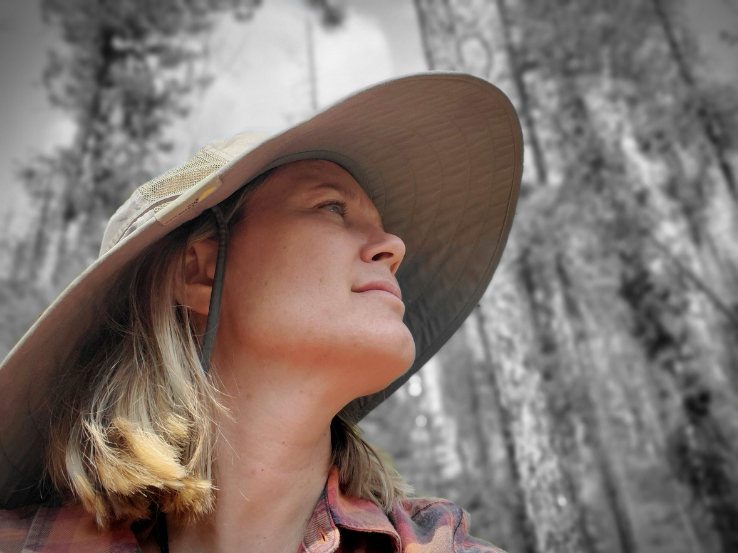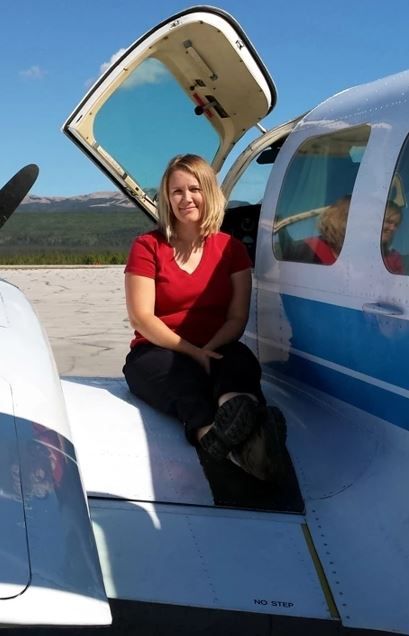Tell us a little bit about yourself.
I was born and raised in Newmarket, Ontario. Following high school, I did my undergraduate and master's degrees at the University of Waterloo in Geography. While doing my master's, I met my now husband, Chris Hopkinson (who also teaches at ULethbridge). He was a PhD student at Wilfrid Laurier University, studying glacial-hydrology - Laurier is just down the street from UWaterloo, so that made for a nice connection! We were both in relationships and after being dumped in the same week, we met up at the local Tim Hortons. Following the master's, I ended up at Queen's University for my PhD in Geography with a concentration in forest hydro-meteorology and remote sensing. Living in Kingston, Ont. was beautiful, but we only lived there for a couple of years and then moved to Nova Scotia for Chris's work. I carried on at Queen's with two great supervisors and flew airborne lidar surveys (in small aircraft) across Canada as a part-time job while working on my PhD. Once that was done, I worked as a postdoctoral researcher on the impacts of human disturbance on boreal ecosystems at Laurier and UWaterloo with two other wonderful mentors. During that time, we also had two kids, which meant for quite a full life of looking after kids and working on academic research at the same time, while also maintaining a small farm with horses. While I didn't graduate from U of L, I knew the University had an innovative and proactive remote sensing and Geography department well before I ever thought we'd end up here!

How long have you been at the U of L and what do you do here?
I have been teaching and doing research off and on here (and at UWaterloo) since 2014 and was hired as a tenure-track assistant professor at the U of L in 2018 (to my absolute delight - it has been my goal since I was teenager to become a professor). My job includes lots of teaching - first-year physical geography (GEOG1000), environmental resources management (GEOG3075), and wetlands (GEOG3440) are my staple courses. I also do a lot of research on how climate change and human disturbances are impacting northern peatlands and permafrost (frozen ground). Climate change is causing these largely moist ecosystems to become drier, making them more susceptible to wildfire. Drying also causes changes in the availability of fire fuels, making the fires more unpredictable than they have been in the past, which is another big concern. My research looks into the implications of peatland change and fire on ecosystem function, but also how these impact communities, policy, and management. To do this, I use field measurements and geospatial technologies, including remote sensing and GIS, within a nationally supported initiative to improve our understanding of fire hazards and risk. To help me with these adventures, I have a great group of clever undergraduate and graduate students who are willing to be dragged out to remote areas to set up experiments and take measurements every summer. Our fieldwork takes us to often wet places, where the water goes into the top of our boots, flooding out our boots and creating “soakers.” Soakers are the norm (as we are too hard for waders), and badly bruised legs seem to be a rite of passage, though by about the second day, the students are pulling me along in the field!
What is the best part of your job? What is the most meaningful part of your job?
There are so many wonderful parts of my job; it is difficult to list them all! I love to teach and work with undergraduate and graduate students. When they get excited about something, I feel like: "Yes!!! I know what you mean; isn't that amazing??!!" Or if they learn something new and they tell me about it, it really makes my day. Watching people grow and develop is also a wonderful part of my job. I meet students in GEOG1000 and then some of them go on in geography and take the exciting courses that we have to offer. Throughout their program, I watch the students mature into critical thinkers, excellent problem solvers, and creative individuals. Following their program, I see them graduate and move into positions of influence, and sometimes, I work with them as professionals. We chat about buying houses, having kids, and moving on with life. It is really neat to see. This is the most meaningful part of my job. Of course, I also love research. It is highly creative and when I see something in the data, it is so exciting, like winning a football game. I also love working in northern environments. They are truly stunning - a rainbow of brightly coloured mosses, pitcher plants, and antioxidant berries that can be fully enjoyed all day, every day while working up north. Working with geospatial information, combined with physics, to understand the natural environment is also highly visual and quantitatively challenging, so it brings together my old loves— art and music.
What are you most excited about moving into the Spring 2022 semester for Geography & Environment?
I am really looking forward to our moving beyond Covid-19 and back into our regular ways of doing things. I have not been working at the University all that much during Covid-19 because our son is too young to be vaccinated. I can't wait to come back and see everyone each day, though as a highly social person, I will have to be a little careful to not be too chatty with everyone in WESB. I am also looking forward to continuing my research with the Canada Wildfire Network, building on new and innovative ways to assess fire fuels and the impacts of fire on northern ecosystems.
What do you enjoy doing outside of work?
I grew up showing horses, mostly hunters and jumpers in southern Ontario. I showed almost every weekend (with a history of working with some of the old greats on the Olympic team). I also worked through the Royal Conservatory of Music in flute and musical theory and played professionally for a few years. Nowadays, I love gardening and making wine and cider on Friday nights with Chris. I am in the early stages of starting to ride a motorcycle and have been able to reach a lofty speed of 20 kph in a parking lot.
